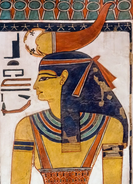Serket
This articleneeds additional citations forverification.(February 2023) |
| Serket | |||||
|---|---|---|---|---|---|
 The Egyptian goddess Serket is often depicted as a woman with a scorpion gracing her crown. She holds theankh,the symbol of life, in one hand and awas-sceptre,representing power, in the other. | |||||
| Name inhieroglyphs | |||||
| Symbol | Scorpion | ||||
| Genealogy | |||||
| Parents | Set,orKhnumandNeith | ||||
| Siblings | Apep(in some myths),Sobek(in some myths) | ||||
| Consort | Horus the YoungerorHorus the Elder | ||||
| Offspring | Nehebkau(in some myths) | ||||
Serket/ˈsɜːrˌkɛt/(Ancient Egyptian:srqt) is thegoddessof healing venomous stings and bites inEgyptian mythology,originally the deification of thescorpion.[2]Her family life is unknown, but she is sometimes credited as the daughter ofNeithandKhnum,making her a sister toSobekandApep.
Scorpion stingslead to paralysis and Serket's name describes this, as it means "(she who) tightens the throat"; however, Serket's name also can be read as meaning "(she who) causes the throat to breathe" and so, as well as being seen as stinging the unrighteous, Serket was seen as one who could cure scorpion stings and the effects of other venoms such assnakebites.
In theart of ancient Egypt,Serket was depicted as a scorpion (a symbol found on the earliest artifacts of the culture, such as fromNaqada III) or to have the body of a scorpion but the head of a woman or as a woman with a scorpion on her head. Although Serket does not appear to have had any temples, she had a sizable number ofpriestsin many communities.
One of the most dangerous species of scorpion, thedeathstalker(Leiurus quinquestriatus) resides inNorth Africaand its sting may kill, so Serket was considered a highly important goddess and sometimes she was considered bypharaohsto be their patron. Her close association with the early rulers implies that she was their protector, notablyScorpion IandScorpion II.
As the protector againstvenomand snakebite, Serket often was said to protect the deities fromApep,the greatsnake-demon of evil, sometimes being depicted as the guard when Apep was captured.
As many of the venomous creatures of Egypt could prove fatal, Serket also was considered a protector of the dead, particularly being associated with venoms and fluids causing stiffening. She was thus said to be the protector of the tents ofembalmersand of thecanopic jarassociated withvenom—the jar of theintestine—which was deified later asQebehsenuef,one of thefour sons of Horus.
| Part ofa serieson |
| Ancient Egyptianreligion |
|---|
 |
|
|
As the guard of one of the canopic jars and a protector, Serket gained a strong association withNeith,Isis,andNephthys,who also performed similar functions. Eventually, Serket began to be identified withIsis,sharing imagery and parentage, until finally, Serket was said to be merely an aspect of Isis, whose cult had become dominant.
It has been suggested that Serket's identification with a scorpion may be a misinterpretation of thedeterminativeof her name and animal associated with her and that could refer not to a scorpion, but rather to awater scorpion(Nepidae). According to this hypothesis, Serket is referred to as "she who gives breath" because of the way water scorpions seem to breathe underwater. The appearance of a waterscorpion must have made it be associated with the scorpion, therefore the use of the goddess for curing scorpion stings and other venomous creatures or maybe exactly because she "causes to breathe", not for the physical similarities of the creatures.[3]
Gallery
[edit]-
Late Periodbronze figure of Isis-Serket
-
Serket and her scorpion,Edfu Temple
-
Serket as seen in theTomb of Nefertari
References
[edit]- ^Zauzich, Karl-Theodor (1992).Hieroglyphs Without Mystery.Austin: University of Texas Press. p. 69.
- ^Pharaonic GodsArchived2008-05-13 at theWayback MachineEgyptian Museum
- ^Spieser, Cathie (2001). "Nouvelles approches de l'image emblématique de Serket: le serpent, la corne et l'uterus".Revue d'Égyptologie.52:251–264.doi:10.2143/RE.52.0.504258.ISSN0035-1849.
Further reading
[edit]- von Känel, Frédérique (1984).Les prêtres-ouâb de Sekhmet et les conjurateurs de Serket(in French). Presses Universitaires de France.



